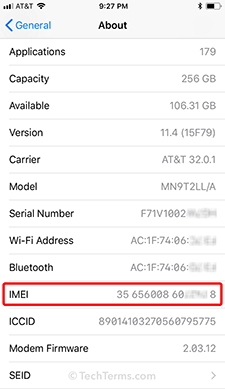IMEI
Stands for "International Mobile Equipment Identity." Every mobile device that connects to a cellular network has a unique IMEI number. This includes cell phones, smartphones, cellular-enabled tablets and smartwatches, and other devices that support cellular data.
The IMEI number uniquely identifies a mobile device. It is separate from the SIM card or UICC number which is linked to a removable card in the device. This means the IMEI can be used to track or locate a specific device, regardless of what card is installed in it. For example, if your phone is stolen and the SIM card is swapped out, your mobile provider can still block access from the stolen phone using the IMEI.
Difference Between the IMEI and Serial Number
An IMEI is similar to a serial number since it is a unique number linked to a hardware device. While serial numbers are generated by the manufacturer, IMEI numbers are produced by the GSMA (Groupe Spéciale Mobile Association), an international organization that oversees mobile network operators. The GSMA provides each mobile device manufacturer with a range of numbers to use for IMEIs on devices they produce.
Manufacturers can choose their own convention for serial numbers, including the length and type of characters (numeric or alphanumeric). IMEI numbers are always 15 digits long, comprised of a 14-digit unique number followed by a "check digit" (or a checksum), which validates the number. A variation of the IMEI, called the IMEISV (IMEI Software Version), includes the 14-digit number plus two digits for the version of the device's software. The IMEISV may change after a software update.
NOTE: Most smartphones allow you to view your device's IMEI in the "About" section of the device settings. Another way to view the IMEI is to press *#06# on the numeric keypad.
 Test Your Knowledge
Test Your Knowledge